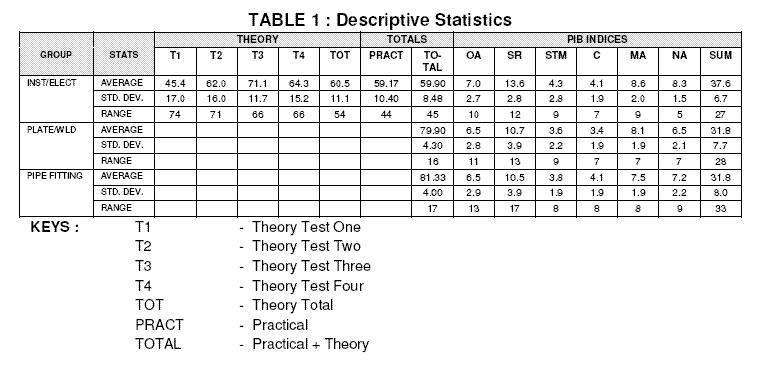Validity of VPIB

P. SCHAAP
D.Com.

Table 2: Correlation Coefficients

DISCUSSION OF RESULTS
It is quite clear, referring to Table 1, that the different groups differ in terms of certain variables as indicated through the descriptive statistic indicators calculated. This again emphasizes the importance of a situational approach toward assessment. The data reveals the psychometric properties of the criteria used in this study. There are clear indications of variability between criteria scores in terms of the standard deviation and inter-correlations obtained that would have had an influence on the results obtained. There is evidence of range restriction as in the case of the final scores of the plate welders and pipe fitters which could inhibit inter-correlations. The average inter-correlation between the theoretical tests of the instrument/electrical candidates is 0.45**. This indicates a certain level of inconsistency in terms of theoretical performance which could inhibit the level of inter-correlation between TOT as a theory criteria score and any other related reliable and valid measure of performance. There is in addition an insignificant inter-correlation coefficient of 0.15 between the practical and theoretical performance of the instrument/electrical group resulting in an additional significant source of variance in the total score due to different attributing factors. The essence of the matter is that validity studies should be interpreted with caution in the light of such evidence, especially concerning composite total scores consisting of different sources of variance which may not relate directly to what the predictor purports to measure.
Referring to Table 2, there are clear indications that the PIB Indices have no significant correlation with the practical performance indicators. The PIB correlates significantly with the theoretical part of performance for the instrument/electrical group. Five of the six PIB indices correlates significantly with T1. Four PIB Indices correlate significantly with TOT. A composite score SUM including OA, SR, MA and NA was calculated using the best predictors. Based on SUM a significantly high correlation coefficient of .59 was obtained between PIB and T1 which is highly acceptable. A significant correlation of .53 was obtained for SUM and TOT which is respectable. A significant correlation of .46 between TOTAL and SUM was obtained for the pipe fitter group which is respectable. These coefficients coincide well with international findings reported by Cascio which indicate that the average predictive validity of cognitive measures and criteria performance is .50.
Based on a multiple regression coefficient of .29 calculated using the stepwise method between the PIB Indices and TOTAL, the NA Index seem to be the best predictor applicable for all groups totalling 170 cases which includes previous data obtained. There are strong grounds for a situational approach in validity studies to be followed in future concerning the groups in question. The group in question and criteria measure used should be considered in validity studies performed and results should not be generalized to other groups.
More studies need to be done including groups with larger numbers before any final conclusion can be made, but at this stage there is a good reason to be very optimistic about the predictive validity of the PIB and Theoretical performance indicators.



